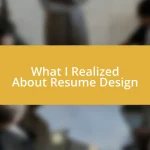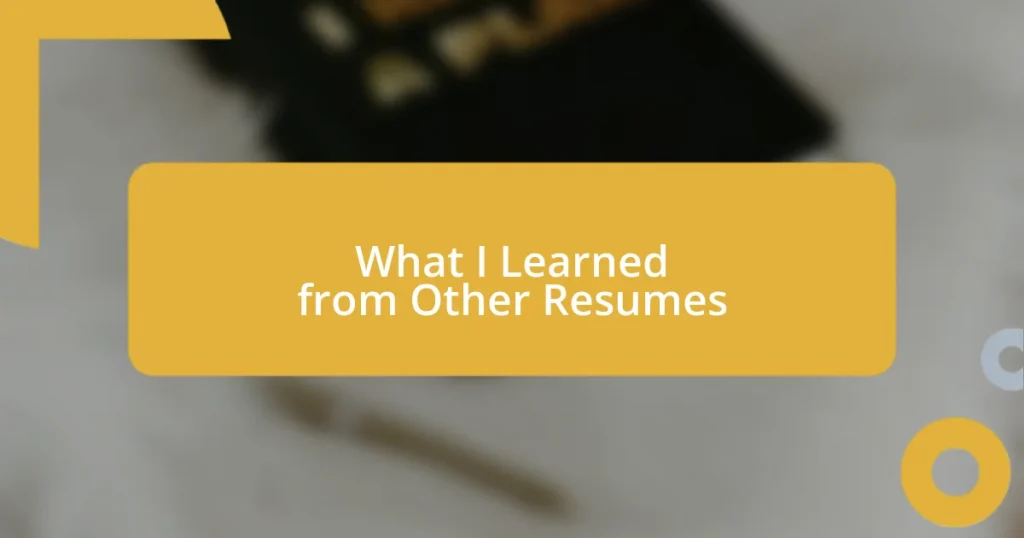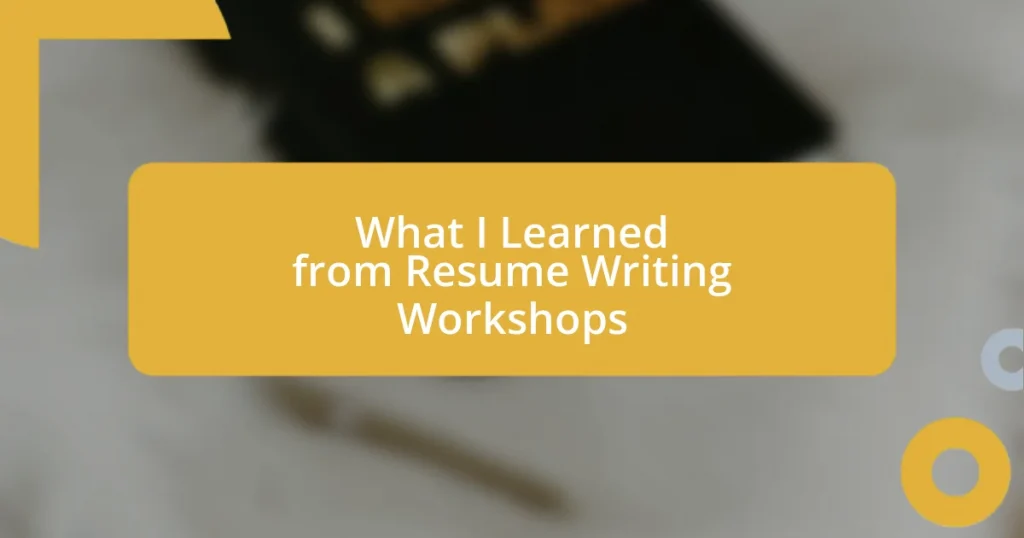Key takeaways:
- Engaging with each panelist through direct eye contact and tailored responses can create a positive atmosphere and help alleviate nerves.
- Effective preparation, including researching panelists and practicing mock interviews, enhances confidence and adaptability during the interview.
- Following up after interviews with a thoughtful message can reinforce your fit for the role and foster genuine connections with interviewers.

Understanding Panel Interviews
Panel interviews can feel a bit daunting at first. I remember walking into one, and the sight of several interviewers at a long table gave me butterflies in my stomach. It’s a unique format where multiple decision-makers come together, each with their own perspectives and questions. Have you ever thought about how that dynamic can actually work in your favor?
As I sat down, I realized that this setup allowed for a more comprehensive evaluation of my skills and fit for the role. Each interviewer had a different focus—some were interested in my technical abilities, while others wanted to gauge my cultural fit. This diversity in questioning not only challenged me but also gave me a chance to showcase various aspects of my experience. What a great opportunity to shine!
One thing I’ve learned is the importance of engaging with each panelist. During my last panel interview, I made it a point to address each person’s questions directly and maintain eye contact, creating a connection. It helped alleviate some of my nerves and made the conversation much more fluid. Have you considered how small interactions can make a big difference in an interview setting?

Preparing for Panel Interviews
Preparing for a panel interview requires a strategic approach. Before my first panel experience, I spent hours researching each panelist’s background, which helped me tailor my responses to their interests. I recommend looking up their LinkedIn profiles to understand their roles and what might be important to them. This knowledge not only boosts your confidence but can also help you establish a rapport during the interview.
Practice is another critical element in preparation. I organized mock interviews with friends, simulating the panel environment by having them take on different roles. It was eye-opening to see how diverse questions could come from various perspectives. The more comfortable I became with unpredictable question patterns, the better equipped I felt when it came time for the actual interview. Have you considered simulating the pressure of multiple interviewers?
Lastly, be mindful of your body language. Throughout my interviews, I noticed how aware I was of the panelists’ reactions, and I realized they were just as focused on me. Maintaining an open posture, nodding in response, and smiling helped build a positive atmosphere. Just remember, the goal is not only to answer questions but also to engage and connect with each panelist.
| Preparation Method | Description |
|---|---|
| Research Panelists | Understand their backgrounds and interests. |
| Mock Interviews | Practice in a simulated panel setting to build confidence. |
| Body Language | Focus on maintaining open and engaging body language. |

Strategies for Successful Responses
When it comes to navigating panel interviews, I’ve found that framing my responses in a structured way makes a tangible difference. For example, using the STAR method—Situation, Task, Action, and Result—helped me organize my thoughts clearly and concisely. I recall a moment when I was asked about a challenging project. By outlining the situation right away, I noticed the panelists leaning in, clearly interested in how I approached the task. It’s all about keeping them engaged while showcasing what I bring to the role.
Here are some strategies that have worked for me:
- Listen Actively: Pay attention to each panelist’s tone and body language. This gives you clues about what they value most.
- Tailor Your Answers: Just like I adjusted my response to the panel’s interests, think about how your skills align with each question.
- Incorporate Questions: After answering, I often turned the table by asking the panelists their thoughts. It can create a dialogue that feels more personable.
Working through these techniques definitely helped me feel more composed and connected during the interview process.

Managing Anxiety During Interviews
Managing anxiety during interviews is a challenge I’ve faced firsthand, especially in a panel setting where multiple eyes are on you. One technique that I found effective was to practice deep breathing exercises before entering the room. I remember standing outside the interview door, taking deep breaths, and visualizing success. It really calmed my racing mind, anchoring me in the moment. Have you ever tried something similar to regain your focus?
Another approach I utilized was positive self-talk. In the days leading up to the interview, I created a list of my achievements and strengths. Each time I felt a wave of anxiety, I reminded myself of these points. This practice shifted my mindset from worry to confidence, helping me to stay grounded during the panel. Think about the last time you reflected on your accomplishments—didn’t it make you feel more empowered?
Lastly, engaging with the panelists can really diffuse anxiety. During my interviews, I focused on making eye contact and asking a clarifying question if needed. There were moments where I sensed my nerves rising, but diverting my attention to the panelists—acknowledging their presence—transformed my anxiety into a more collaborative atmosphere. Have you ever considered turning your nervous energy into curiosity about the panelists? It can be a game changer!

Engaging with Multiple Interviewers
Engaging with multiple interviewers can feel like a juggling act, but I’ve found that making eye contact with each panelist really shines a light on the interaction. I remember during one of my interviews, I consciously shifted my gaze around the room, making sure to connect with everyone. It was surprising how much more attentive they seemed to be; I could see them nodding along as I spoke. Have you ever noticed how being seen can change the dynamics of a conversation? It creates an environment where everyone feels involved.
I’ve also learned the importance of adapting my communication style to fit the mood of the panel as a whole. There was an instance where I sensed the interviewers were looking for a more conversational approach rather than formal responses. I decided to infuse a touch of humor into my answers, and it instantly lightened the atmosphere. It felt like we were all in the same boat, which fostered an authentic dialogue. Isn’t it fascinating how a well-placed joke can break the ice in even the most tense situations?
Sometimes, a simple pause can be your best friend when engaging with multiple interviewers. I’ve found that taking a moment to consider my response not only helps to articulate my thoughts but also allows the panelists to absorb what I’ve said. In one particular interview, I paused after a compelling question, letting the silence linger just a bit. And you know what? Instead of filling that void with nervous chatter, the panelists leaned in, genuinely eager to hear my thoughts. Have you ever tried embracing silence? It can transform the rhythm of the conversation and make the moment feel more collaborative.

Following Up After Interviews
Following up after an interview is a crucial step that many candidates overlook, thinking once it’s done, it’s over. I distinctly remember a time when I sent a brief thank-you email just a day after my panel interview. The responses from the interviewers were incredibly positive and reaffirmed my impression that taking this extra step truly made me stand out. How would you feel if your thoughtful follow-up resulted in a warmer reception?
In my experience, a well-crafted follow-up can also be an opportunity to reinforce your fit for the role. After one interview, I reflected on a specific project I’d mentioned and included a link to a relevant article I had written. This not only reminded them of our conversation but also showcased my expertise in action. Isn’t it amazing how a little effort to share more about yourself can leave a lasting impression?
I’ve also learned the importance of timing in follow-up communication. Waiting too long can signal disinterest, while reaching out too soon might come off as overly eager. I generally aim for about 48 hours after the interview. During one of my follow-ups, I showed appreciation for not only the interview opportunity but also for the insights shared by the panelists. This blend of professionalism and personal touch can help foster a genuine connection. Have you ever considered what message your follow-up conveys?

Reflecting on Interview Outcomes
Reflecting on the outcomes of panel interviews can often lead to a spectrum of emotions. I remember walking out of one particular interview feeling a mix of excitement and apprehension. Did I answer the questions confidently enough? Those feelings lingered for days, making it hard to concentrate on anything else until I got the call. It’s funny how the human mind often focuses on self-doubt rather than celebrating our efforts, isn’t it?
Upon receiving feedback, I found that analyzing my responses helped me immensely. For instance, one panelist mentioned appreciating my structured approach to problem-solving, which reaffirmed my belief in preparing an outline for such scenarios. However, he encouraged me to include more personal anecdotes in my answers. I realized that weaving my own experiences into the responses would have connected me more with the interviewers. Have you ever reflected on feedback that highlighted your strengths while also offering constructive criticism? It’s a valuable reminder that each interview is a learning opportunity.
Lastly, I’ve come to appreciate the power of self-reflection post-interview. By journaling my thoughts, I uncovered patterns in how I’d handled tricky questions and the ways I engaged with different personalities on the panel. This practice not only helped me articulate my thoughts more clearly but also unveiled areas for growth. It’s almost therapeutic, similar to talking it out with a friend—wouldn’t you agree? Taking that time to reflect and process can set the stage for better performance in future interviews.















